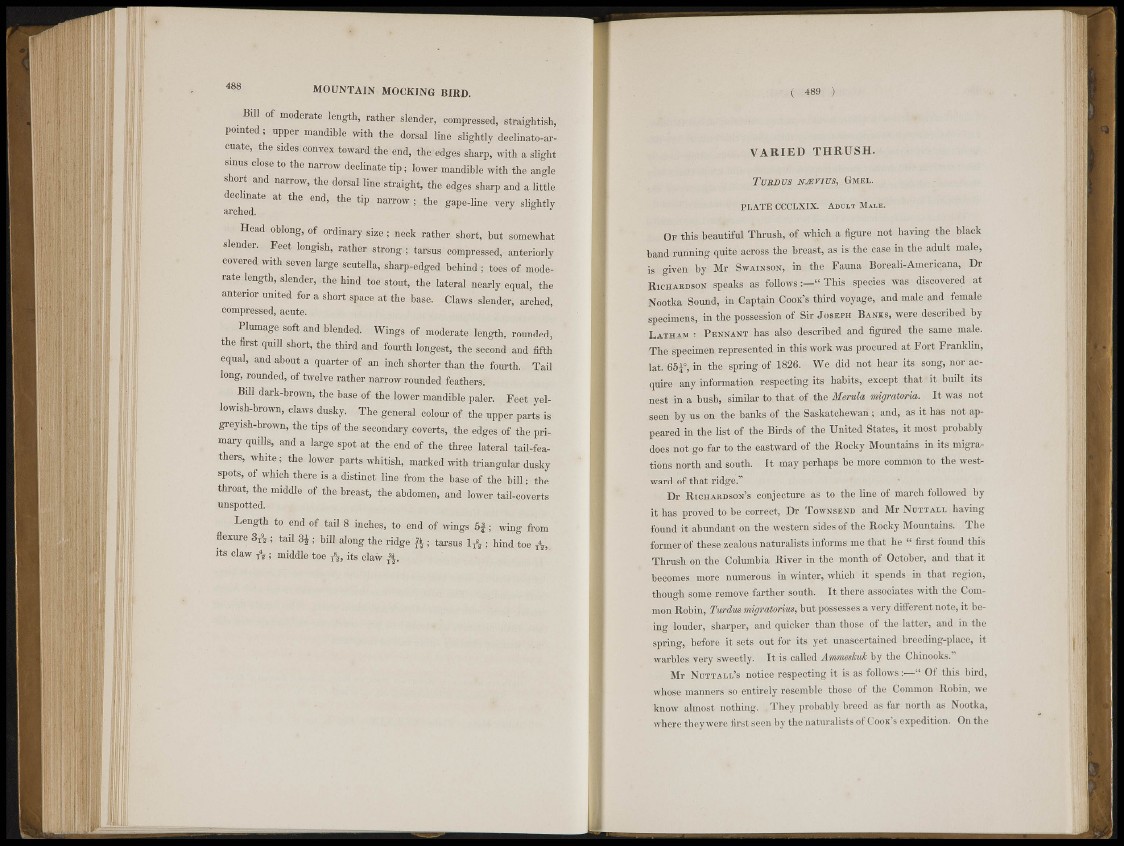
488
MOUNTAIN MOCKING BIRI).
Bill Of moderate length, rather slender, com,.resse,1, straightish,
pointed- upper mandible with the dorsal line slightly ,declinato-arcuate,
the sides,convex toward the end, tlieedg.* sharp, with a slight
•S"1U5 c l " s o t H t h p n a m w ^cimate tip ; lower mandible with the angle
short and narrow, the dorsal line straight, the edges sharp and a little
a c M 1 ^ H theï V t i%n a r r o w 5 >«"> gape-line very slightly
H S a ê , o b t o n g , # ; o K | | ^ . s i oe . 1KH .
k ,.a t h c r fh(wt) b n l soln(nv]lat
slender. ÏVot longi.sh, rather strong ; tarsus compressed, anteriorly
covered with seven large scuteUa, sharp-edged behindMfQ.es of moderate
length, slender, ,the hind toe,stout,.the- lateral nearly equal, the
anterior united -fi,r a short space at the base. Claws, slender, arched,
compressed, acute. .1
Plumage soft and blended. Wings of moderate length, rounded^
the first quill short, thè third and fourth longest, the,second and fifth
«quai, ,uul about a quarter of an inch shorter than the fourth. Tail
long,: Bounded, of twelve rather narrow rounded feathers:
Bill dark-brown, the base of the loweipmandible paler. Eeet i yellowish
brown, claws dusky. -The general colour of the upper parts is
grey»h-brown,,the tips of the .secondary coverts, the edges of the primary
quills, and a & g e spot at the end of the three lateral tail-feathers,
whi t « the lower parts whitish, marked with triangular dusky
Spqfe oi which there is a 'distinct line from the,base3of the bill; the
throat, the middle of the breast, the abdomen, and lower tail-coverts
unspotted. •
Length to. end of tail 8 inches, to end ¡of wings 5f ; wing from
flexure 8,', ; tail 3f ; billalong the ridge ft; tarsus l à ; liiml toc t%,
its claw A ; middle toe its da<v
( 48»
VA II IK J) THRUSH.
TLBVUS NJEVIVS, (iiMKl.
JM.ATK CCCI-XIX. ADI:J.T Mai.»:.
OF this beautiful Thrush, of which a figure not having the black
band running (1uite across the breast, as is the. case in the adult male,
M m H Jlr Sw.uxsos-,,, iôj the Fauna lioreali-Amerieana, Dr
Bjchabdson speaks ax fqlj'o«:«-:—" This species was discovered at
Nootka Sound, in Captain Cook's third voyage, and male and female
spécimens, in the possession of Sir Joseph Banks, were described by
Satham : BennAnt has also described and figured thé same male.
The specimen representcjd in this work.was procured at Fort Franklin,
lat. 65j", in the spring of, 1826. We did not hear its song, nor acquire
any information respecting its habits,,, except that, it built its
nest i» a bush, similar to that of the MemU migratoria. It was not
seen by us on. the: bank* «f the Saskatchewan ;.-and, as it has not appeared
in the list of the. Birds of the United States, it most probably
does not go far to the eastward of the Rocky Mountains in its migrations
north and south. It may perhaps be more common to the westward
of tlmt ridge."
Dr Richardson's conjecture as to the line of march followed by
it has; proved' to be correct, Dr Townsend and Mr Nut tal I having
found it abundiuitfiin the western sides of the Rocky Mountains. The
former of these zealous naturalists informs me that he " first found this
Thrush, » the Columbia River in the month of October, and that it
becomes, more numerous in winter, which it spends in that region,
though some: remove farther south. It there associates with the Common
Robin, M i miiffratorims, but possesses a very different note, it being
louder, sharper, and quicker than those of the latter, and in the
spring, before it sftts o.ut for its yet unascertained breeding-place, it
warbles very sweetly. It is called AMMMKUH by the Chinooks."
Mr NirTTAi.u's notice respecting lit is as follows :—>.','• Of this bird,
whose manners Bo entirely resemble those of the Common Robin, we
know almost nothing. . They probably breed as far north as Nootka,
where they were firstseen by the naturalists of Cook's expedition. On the